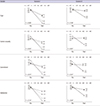1. Organization for Economic Co-operation and Development. Health at a Glance 2013: OECD Indicators. Paris: Organization for Economic Co-operation and Development;2013. p. 83–134.
2. World Health Organization. The Second Global Patient Safety Challenge: Safe Surgery Saves Lives. Geneva: World Health Organization;2008. p. 4–6.
3. Nabi RL. Exploring the framing effects of emotion: do discrete emotions differentially influence information accessibility, information seeking, and policy preference? Communic Res. 2003; 30:224–247.
4. Kohn LT, Corrigan JM, Donaldson MS. To Err Is Human: Building a Safer Health System. Washington, D.C.: National Academy Press;2000. p. 1–2.
5. Berlin L. Will saying “I'm sorry” prevent a malpractice lawsuit? AJR Am J Roentgenol. 2006; 187:10–15.
6. Itoh K, Andersen HB. Patient reactions to staff apology after adverse event and changes of their views in four year interval. In : Palanque P, Vanderdonckt J, Winckler M, editors. Human Error, Safety and Systems Development: Lecture Notes in Computer Science Volume 5962. Berlin: Springer;2010. p. 28–43.
7. Fritzsche PJ. Communication: the key to improved patient care. Radiology. 2005; 234:13–14.
8. Beach MC, Roter DL, Wang NY, Duggan PS, Cooper LA. Are physicians' attitudes of respect accurately perceived by patients and associated with more positive communication behaviors? Patient Educ Couns. 2006; 62:347–354.
9. Mellor AC, Milgrom P. Dentists' attitudes toward frustrating patient visits: relationship to satisfaction and malpractice complaints. Community Dent Oral Epidemiol. 1995; 23:15–19.
10. Nazione S, Pace K. An experimental study of medical error explanations: do apology, empathy, corrective action, and compensation alter intentions and attitudes? J Health Commun. 2015; 20:1422–1432.
11. Beck RS, Daughtridge R, Sloane PD. Physician-patient communication in the primary care office: a systematic review. J Am Board Fam Pract. 2002; 15:25–38.
12. Newsome PR, Wright GH. A review of patient satisfaction: 2. Dental patient satisfaction: an appraisal of recent literature. Br Dent J. 1999; 186:166–170.
13. Carmack HJ. Bearing witness to the ethics of practice: storying physicians' medical mistake narratives. Health Commun. 2010; 25:449–458.
14. Wertz EK, Kim S. Cultural issues in crisis communication: a comparative study of messages chosen by South Korean and US print media. J Commun Manag (Lond). 2010; 14:81–94.
15. An SK, Gower KK, Cho SH. Level of crisis responsibility and crisis response strategies of the media. J Commun Manag (Lond). 2011; 15:70–83.
16. Coombs WT. The value of communication during a crisis: insights from strategic communication research. Bus Horiz. 2015; 58:141–148.
17. Grappi S, Romani S. Company post-crisis communication strategies and the psychological mechanism underlying consumer reactions. J Public Relat Res. 2015; 27:22–45.
18. Coombs WT. Ongoing Crisis Communication: Planning, Managing, and Responding. Thousand Oaks, CA: Sage;1991. p. 24–231.
19. Coombs WT. Designing post-crisis messages: lessons for crisis response strategies. Rev Bus. 2000; 21:37–41.
20. Robbennolt JK. Apologies and medical error. Clin Orthop Relat Res. 2009; 467:376–382.
21. Coombs WT, Holladay SJ. The negative communication dynamic: exploring the impact of stakeholder affect on behavioral intentions. J Commun Manag (Lond). 2007; 11:300–312.
22. Lee BK. Audience-oriented approach to crisis communication: a study of Hong Kong consumers' evaluation of an organizational crisis. Communic Res. 2004; 31:600–618.
23. Hon LC, Grunig JE. Guidelines for Measuring Relationships in Public Relations. Gainesville, FL: Institute for Public Relations;1999. p. 2–11.
24. Botha E, van der Waldt DL. Relationship antecedents that impact on outcomes of strategic stakeholder alliances. Afr J Bus Manag. 2010; 4:1629–1638.
25. Wallace E, Lowry J, Smith SM, Fahey T. The epidemiology of malpractice claims in primary care: a systematic review. BMJ Open. 2013; 3:e002929.
26. Mazor KM, Simon SR, Gurwitz JH. Communicating with patients about medical errors: a review of the literature. Arch Intern Med. 2004; 164:1690–1697.
27. Elsbach KD. Accounts, excuses, and apologies: a theory of image restoration strategies by William L. Benoit. Adm Sci Q. 1997; 42:584–586.
28. Liebman CB, Hyman CS. A mediation skills model to manage disclosure of errors and adverse events to patients. Health Aff (Millwood). 2004; 23:22–32.
29. Claeys AS, Cauberghe V, Vyncke P. Restoring reputations in times of crisis: an experimental study of the situational crisis communication theory and the moderating effects of locus of control. Public Relat Rev. 2010; 36:256–262.
30. Noland C, Carl WJ. “It's not our ass”: medical resident sense-making regarding lawsuits. Health Commun. 2006; 20:81–89.
31. Hannawa AF. Negotiating medical virtues: toward the development of a physician mistake disclosure model. Health Commun. 2009; 24:391–399.
32. Crouch EA, Wilson R, Zeise L. The risks of drinking water. Water Resour Res. 1983; 19:1359–1375.
33. Levinson W, Roter DL, Mullooly JP, Dull VT, Frankel RM. Physician-patient communication. The relationship with malpractice claims among primary care physicians and surgeons. JAMA. 1997; 277:553–559.
34. Harris CR, Jenkins M, Glaser D. Gender differences in risk assessment: why do women take fewer risks than men? Judgm Decis Mak. 2006; 1:48–63.
35. Leikas S, Lindeman M, Roininen K, Lähteenmäki L. Food risk perceptions, gender, and individual differences in avoidance and approach motivation, intuitive and analytic thinking styles, and anxiety. Appetite. 2007; 48:232–240.
36. Evans G, Durant J. The relationship between knowledge and attitudes in the public understanding of science in Britain. Public Underst Sci. 1995; 4:57–74.
37. Peak JS. Types of apology ad messages and public's response. Korean J Advert Public Relat. 2006; 8:184–229.










 PDF
PDF ePub
ePub Citation
Citation Print
Print





 XML Download
XML Download